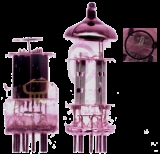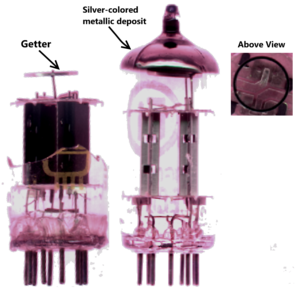
Getter
Encyclopedia

Adsorption
Adsorption is the adhesion of atoms, ions, biomolecules or molecules of gas, liquid, or dissolved solids to a surface. This process creates a film of the adsorbate on the surface of the adsorbent. It differs from absorption, in which a fluid permeates or is dissolved by a liquid or solid...
. Thus the getter removes small amounts of gas from the evacuated space.
The getter is usually a coating applied to a surface within the evacuated chamber.
A vacuum is created by connecting a closed container to a vacuum pump
Vacuum pump
A vacuum pump is a device that removes gas molecules from a sealed volume in order to leave behind a partial vacuum. The first vacuum pump was invented in 1650 by Otto von Guericke.- Types :Pumps can be broadly categorized according to three techniques:...
. After achieving a vacuum, the container can be sealed, or the vacuum pump can be left running. Small amounts of gas remain in the container after pumping, and the inner surfaces of the container can slowly release adsorbed gases for a long time. Although it weighs almost nothing and has no moving parts, a getter is itself a vacuum pump.
Getters obviously cannot react permanently with inert gas
Inert gas
An inert gas is a non-reactive gas used during chemical synthesis, chemical analysis, or preservation of reactive materials. Inert gases are selected for specific settings for which they are functionally inert since the cost of the gas and the cost of purifying the gas are usually a consideration...
es, though some getters will adsorb them in a reversible fashion. Also, hydrogen
Hydrogen
Hydrogen is the chemical element with atomic number 1. It is represented by the symbol H. With an average atomic weight of , hydrogen is the lightest and most abundant chemical element, constituting roughly 75% of the Universe's chemical elemental mass. Stars in the main sequence are mainly...
is usually handled by adsorption rather than reaction.
Getters are especially important in sealed systems, such as vacuum tube
Vacuum tube
In electronics, a vacuum tube, electron tube , or thermionic valve , reduced to simply "tube" or "valve" in everyday parlance, is a device that relies on the flow of electric current through a vacuum...
s, including cathode ray tube
Cathode ray tube
The cathode ray tube is a vacuum tube containing an electron gun and a fluorescent screen used to view images. It has a means to accelerate and deflect the electron beam onto the fluorescent screen to create the images. The image may represent electrical waveforms , pictures , radar targets and...
s (CRTs), and vacuum insulated panel
Vacuum insulated panel
A vacuum insulated panel is a form of thermal insulation consisting of a nearly gas-tight enclosure surrounding a rigid core, from which the air has been evacuated...
s.
Small amounts of gas within a vacuum tube will ionize, causing undesired conduction leading to major malfunction.
Small amounts of gas within a vacuum insulated panel can greatly compromise its insulation value. Getters help to maintain the vacuum.
Flashed getters
"Flashed getters" are prepared by arranging a reservoir of a volatile and reactive material inside the vacuum system. Once the system is evacuated and sealed, the material is heated, usually by RF induction heatingInduction heating
Induction heating is the process of heating an electrically conducting object by electromagnetic induction, where eddy currents are generated within the metal and resistance leads to Joule heating of the metal...
, and evaporates, depositing itself on the walls to leave a coating. Flashed getters are commonly used in vacuum tube
Vacuum tube
In electronics, a vacuum tube, electron tube , or thermionic valve , reduced to simply "tube" or "valve" in everyday parlance, is a device that relies on the flow of electric current through a vacuum...
s, and the standard flashed getter material is barium
Barium
Barium is a chemical element with the symbol Ba and atomic number 56. It is the fifth element in Group 2, a soft silvery metallic alkaline earth metal. Barium is never found in nature in its pure form due to its reactivity with air. Its oxide is historically known as baryta but it reacts with...
. It can usually be seen as a silvery metallic spot on the inside of the tube's glass envelope. Large transmitting and specialized tubes often use more exotic getters, including aluminium
Aluminium
Aluminium or aluminum is a silvery white member of the boron group of chemical elements. It has the symbol Al, and its atomic number is 13. It is not soluble in water under normal circumstances....
, magnesium
Magnesium
Magnesium is a chemical element with the symbol Mg, atomic number 12, and common oxidation number +2. It is an alkaline earth metal and the eighth most abundant element in the Earth's crust and ninth in the known universe as a whole...
, calcium
Calcium
Calcium is the chemical element with the symbol Ca and atomic number 20. It has an atomic mass of 40.078 amu. Calcium is a soft gray alkaline earth metal, and is the fifth-most-abundant element by mass in the Earth's crust...
, sodium
Sodium
Sodium is a chemical element with the symbol Na and atomic number 11. It is a soft, silvery-white, highly reactive metal and is a member of the alkali metals; its only stable isotope is 23Na. It is an abundant element that exists in numerous minerals, most commonly as sodium chloride...
, strontium
Strontium
Strontium is a chemical element with the symbol Sr and the atomic number 38. An alkaline earth metal, strontium is a soft silver-white or yellowish metallic element that is highly reactive chemically. The metal turns yellow when exposed to air. It occurs naturally in the minerals celestine and...
, caesium
Caesium
Caesium or cesium is the chemical element with the symbol Cs and atomic number 55. It is a soft, silvery-gold alkali metal with a melting point of 28 °C , which makes it one of only five elemental metals that are liquid at room temperature...
and phosphorus
Phosphorus
Phosphorus is the chemical element that has the symbol P and atomic number 15. A multivalent nonmetal of the nitrogen group, phosphorus as a mineral is almost always present in its maximally oxidized state, as inorganic phosphate rocks...
.
If the tube gets broken, the getter reacts with incoming air leaving a white deposit inside the tube, and it becomes useless; for this reason, flashed getters are not used in systems which are intended to be opened. A functioning phosphorus getter looks very much like an oxidised metal getter, though it has an iridescent pink or orange appearance which oxidised metal getters lack. Phosphorus was frequently used before metallic getters were developed.
In systems which need to be opened to air for maintenance, a titanium sublimation pump
Titanium sublimation pump
A Titanium sublimation pump may be used as a component of ultra high vacuum systems.- Principle of Operation :Its construction and principle of operation is extremely simple. It consists of a titanium filament through which a high current is passed periodically...
provides similar functionality to flashed getters, but can be flashed repeatedly. Alternatively, nonevaporable getters may be used.
Non-evaporable getters
Non-evaporable getters which work at high temperature generally consist of a film of a special alloy, often primarily zirconiumZirconium
Zirconium is a chemical element with the symbol Zr and atomic number 40. The name of zirconium is taken from the mineral zircon. Its atomic mass is 91.224. It is a lustrous, grey-white, strong transition metal that resembles titanium...
; the requirement is that the alloy materials must form a passivation layer at room temperature which disappears when heated.
Common alloys have names of the form St (Stabil) followed by a number:
- St 707 is 70% zirconiumZirconiumZirconium is a chemical element with the symbol Zr and atomic number 40. The name of zirconium is taken from the mineral zircon. Its atomic mass is 91.224. It is a lustrous, grey-white, strong transition metal that resembles titanium...
, 24.6% vanadiumVanadiumVanadium is a chemical element with the symbol V and atomic number 23. It is a hard, silvery gray, ductile and malleable transition metal. The formation of an oxide layer stabilizes the metal against oxidation. The element is found only in chemically combined form in nature...
and the balance ironIronIron is a chemical element with the symbol Fe and atomic number 26. It is a metal in the first transition series. It is the most common element forming the planet Earth as a whole, forming much of Earth's outer and inner core. It is the fourth most common element in the Earth's crust...
, - St 787 is 80.8% zirconiumZirconiumZirconium is a chemical element with the symbol Zr and atomic number 40. The name of zirconium is taken from the mineral zircon. Its atomic mass is 91.224. It is a lustrous, grey-white, strong transition metal that resembles titanium...
, 14.2% cobaltCobaltCobalt is a chemical element with symbol Co and atomic number 27. It is found naturally only in chemically combined form. The free element, produced by reductive smelting, is a hard, lustrous, silver-gray metal....
and balance mischmetalMischmetalMischmetal is an alloy of rare earth elements in various naturally occurring proportions. It is also called cerium mischmetal, rare earth mischmetal or misch metal. A typical composition includes approximately 50% cerium and 25% lanthanum, with small amounts of neodymium and praseodymium...
, - St 101 is 84% zirconiumZirconiumZirconium is a chemical element with the symbol Zr and atomic number 40. The name of zirconium is taken from the mineral zircon. Its atomic mass is 91.224. It is a lustrous, grey-white, strong transition metal that resembles titanium...
and 16% aluminiumAluminiumAluminium or aluminum is a silvery white member of the boron group of chemical elements. It has the symbol Al, and its atomic number is 13. It is not soluble in water under normal circumstances....
.
In tubes used in electronics, the getter material coats plates within the tube which are heated in normal operation; when getters are used within more general vacuum systems, such as in semiconductor manufacturing, they are introduced as separate pieces of equipment in the vacuum chamber, and turned on when needed.
It is of course important not to heat the getter when the system is not already in a good vacuum.

